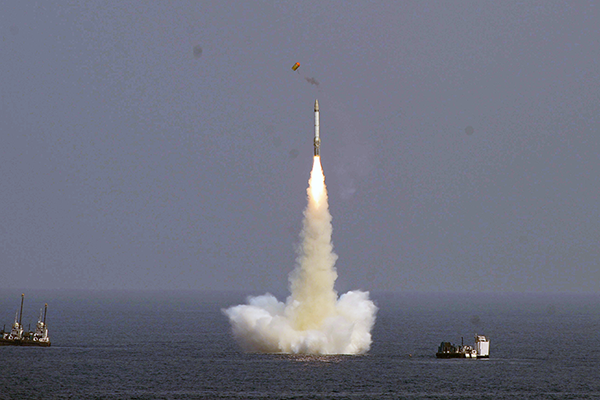India, on 14 October, successfully tested a nuclear-capable ballistic missile from its solitary nuclear-powered submarine INS Arihant, and promptly declared that having an ‘assured retaliatory capability’ was in tune with the country’s `credible minimum deterrence’ against the first-use of nuclear weapons by an adversary.
A brief statement by the defence ministry did not identify the submarine-launched ballistic missile (SLBM) tested from the 6,000-tonne INS Arihant, which became fully operational in 2018, in the Bay of Bengal.
Sources, however, said that the SLBM tested was the B-O5 or K-15 missile with a strike range of 750-km. “INS Arihant is armed with the short-range K-15 missiles. Developmental trials of the K-4 SLBM (with a 3,500-km range) have been completed but it is yet to be fully inducted,” a source said.
This is the first time the launch of an SLBM from INS Arihant has been announced by the government. It comes at a time when India and China continue to have over 50,000 soldiers each, backed by heavy-duty weapon systems, ranged against each other along the frontier in eastern Ladakh, with the military confrontation there now into its 30th month.
The world is also currently watching with bated breath the ongoing Russia-Ukraine war, where the threat of use of nuclear weapons is being considered the most serious since the Cuban missile crisis of 1962.
The MoD, on its part, said, “The SLBM was tested to a predetermined range and impacted the target area in the Bay of Bengal with very high accuracy. All operational and technological parameters of the weapon system have been validated.”
“The successful user training launch of the SLBM by INS Arihant is significant to prove crew competency and validate the SSBN (naval parlance for nuclear-propelled submarines armed with nuclear-tipped ballistic missiles) programme, a key element of India’s nuclear deterrence capability. A robust, survivable and assured retaliatory capability is in keeping with India’s policy to have ‘credible minimum deterrence’ that underpins its ‘no-first use’ commitment,” the statement added.
INS Arihant does give some teeth to the weakest leg of India’s existing nuclear triad – the capability to fire nukes from land, air and sea – but much larger SSBNs that can carry longer range missiles are required to make it more credible.
The other two legs of the triad are, of course, much more robust with the induction of the land-based Agni series of ballistic missiles as well as fighters like Sukhoi-30MKIs, Mirage-2000s and Rafales that are capable of dropping nuclear gravity bombs.
Under the Rs 90,000 crore top-secret advanced technology vessel (ATV) project, India is currently building three more SSBNs to follow INS Arihant, which is propelled by an 83 MW pressurized light-water reactor at its core.
The second such submarine, INS Arighat, is slated to become fully operational next year after some delay. The vessel will be followed by two 7,000-tonne SSBNs, currently called S-4 and S-4*, under the ATV project. There is also the plan to build 13,500-tonne SSBNs with much more powerful 190 MW reactors.
Concurrently, the K-4 SLBM is to be followed by the K-5 and K-6 missiles in the 5,000 to 6,000-km class. All this will decidedly narrow the gap with countries like the US, Russia and China, which have much larger SSBNs with over 5,000-km range missiles.
Much more capable SSBNs will give India’s deterrence posture greater credibility because they are considered the most secure, survivable and potent platforms for retaliatory strikes after a surprise first-strike by an adversary.

















